All photographs by the present author, except for that of James Clarke Hook's painting, which was kindly contributed by the National Maritime Museum, and remains the museum's copyright. The others may be used without prior permission for any scholarly or educational purpose as long as you (1) credit the photographer and (2) link your document to this URL in a web document or cite the Victorian Web in a print one. Where the Old Royal Naval College granted reproduction rights, this too should be credited. Click on the images for larger pictures.
The Old Royal Naval College, Exterior

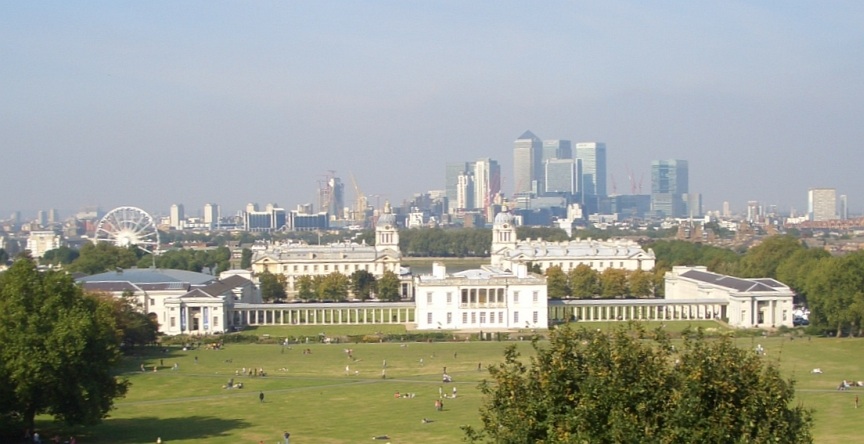
Left: The Thames frontage of the Old Royal Naval College, Greenwich, London SE10. Right: A view of the College and associated buildings from Greenwich Hill.
The Royal Naval College was formerly the Greenwich Hospital for naval pensioners, on the lines of the Chelsea Hospital for army veterans. A listed building, it was the work of Sir Christopher Wren, Nicholas Hawksmoor (as Wren's assistant), Sir John Vanbrugh (successor to Wren) and others (see Weinreb et al. 728-9), and was built 1694-1742, with later additions. It is on the site of Greenwich Palace, where Henry VIII, Queen Mary, and Elizabeth I were all born, in Greenwich, London SE10. Although it now houses the University of Greenwich and Trinity College of Music, key areas are open to the public as part of Greenwich's World Heritage site. Its extent is better seen from Greenwich hill, with Canary Wharf in the distance.
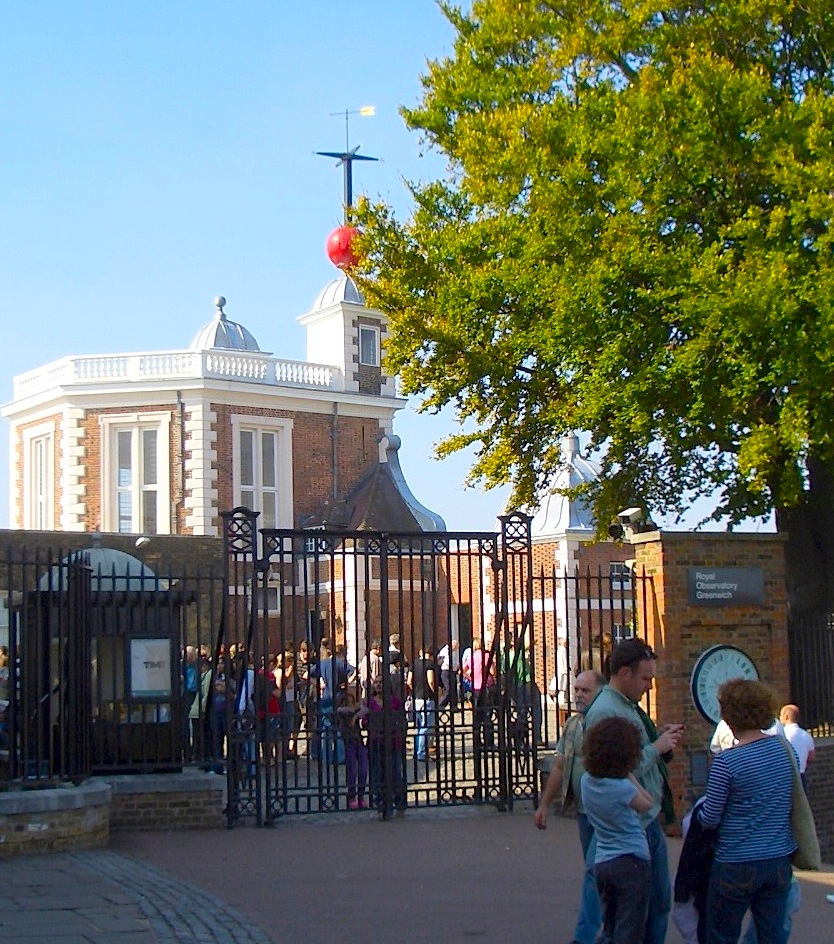

Left: The Royal Observatory, on Greenwich Hill. Right: The Bellot Memorial.
Despite its much longer history, and the encroachments of recent times as well, this complex has much to offer those with a special interest in the architecture, art, history and science of the Victorian age. One example is the Royal Observatory on Greenwich Hill, the foundation stone of which was laid in 1675, but which was developed greatly during the nineteenth century. For example, in 1840, a meteorological and magnetic department was instituted, and in 1888 Greenwich Mean Time was established for England, Wales and Ireland (see Weinreb et al. 730). Down by the river meanwhile, another familiar, albeit smaller, landmark had appeared: Philip Hardwick's obelisk-style memorial of 1855 to the explorer Joseph René Bellot, who had met his death on one of the doomed searches for the lost Franklin Expedition.
Part of the beauty of the whole Greenwich complex comes from its setting. The fine landscaping around the Old Royal Naval College owes a great deal to Hardwick himself, the mid-nineteenth-century Surveyor to the Greenwich Hospital. His 1850 layout enveloped the hospital with its "complementary version of baroque landscape." Recent project managers have found Hardwick's plan to be both sympathetic to what had gone before, and excellent in itself, so that it expressed "the design intent of the earlier schemes and [offered] a goal for restoration work" ("Maritime Greenwich," 32, 37).
The Old Royal Naval College, Interior
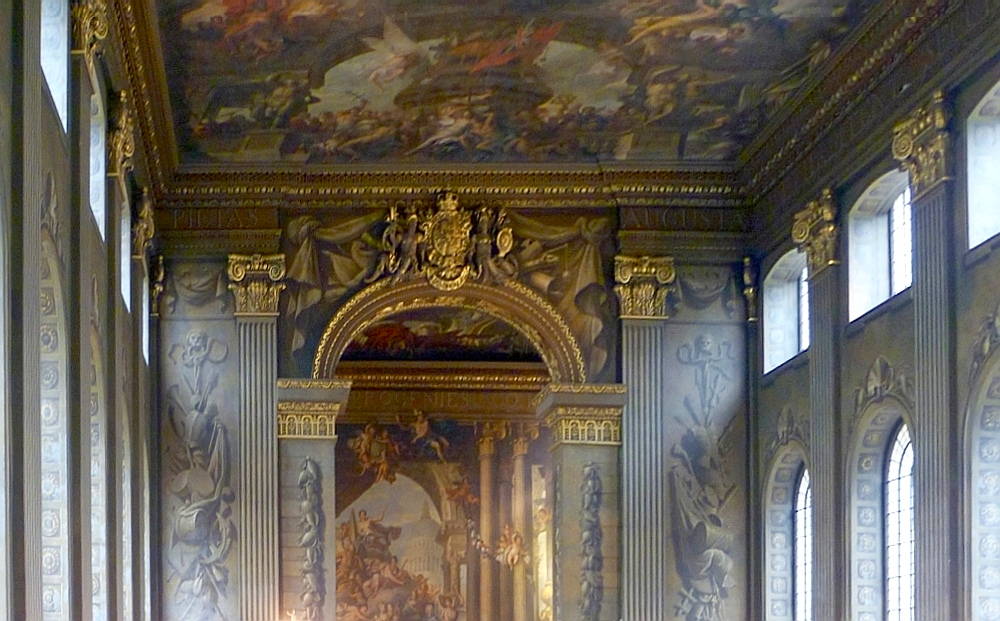
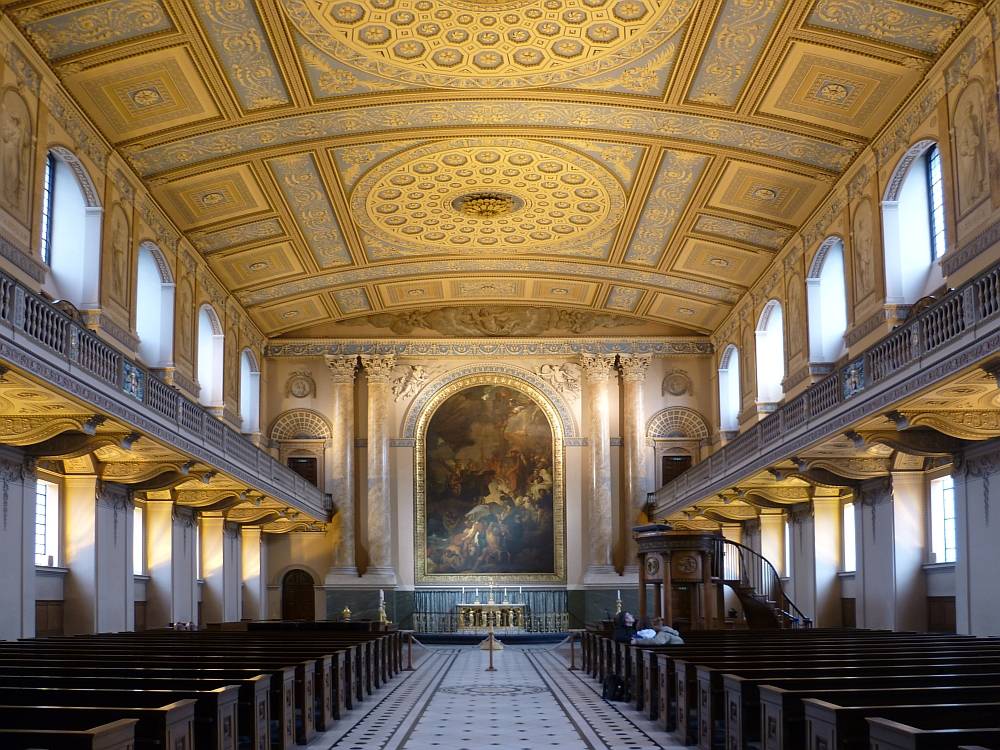
Left: The Painted Hall in King William's Building to the right. Right: The interior of the chapel, in Queen Mary's Building to the left.
"I then went to see the foundation of the Hall and Chapel at Greenwich Hospital," wrote John Evelyn laconically in his diary on 9 June 1698, at that time much more concerned about his own household matters than with beautiful architecture (336). He could not have guessed that the project thus commenced would become one of England's treasures. Under each of the two prominent domes of the Old Royal Naval College lies a richly decorated architectural masterpiece. The Painted Hall is the great work of Sir James Thornhill (1675/6-1734): "Thornhill worked here for nearly twenty years, receiving £3 a yard for the ceiling and £1 a yard for the walls; but he has left us a legacy not easily reckoned in pounds" (Mee 844). Designed by another pioneer of neo-classicism, James "Athenian" Stuart (1713-1788), the chapel was completed in 1779 after Wren's original chapel was destroyed by fire. Dedicated to St Peter and St Paul, it has splendid painted and sculptural work by Benjamin West (1738-1820), most notably his celebrated painting behind the altar, of St Paul miraculously surviving a viper's bite when he was shipwrecked on Malta.
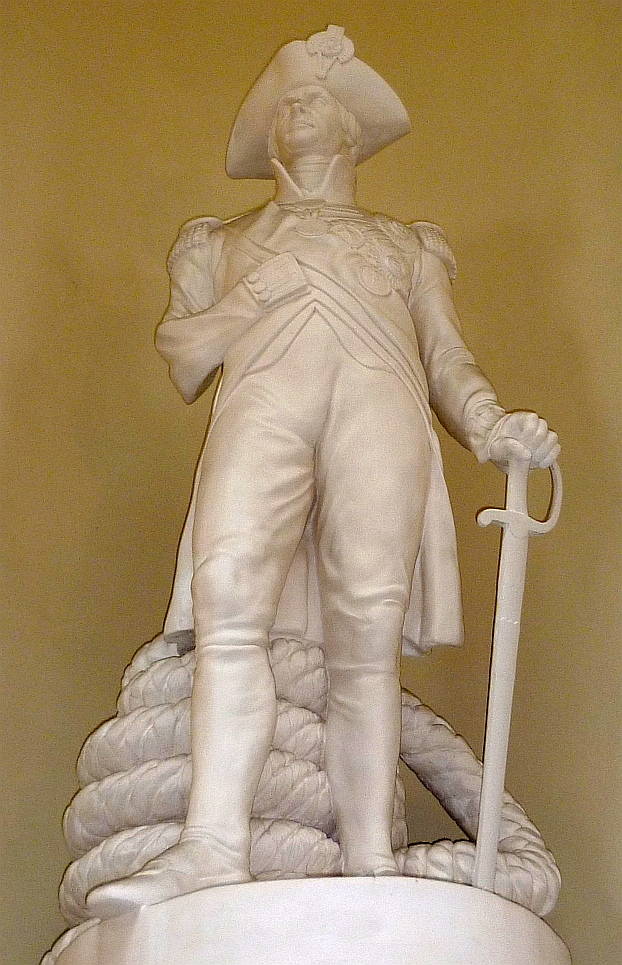

Left: Richard Westmacott's memorial to the Franklin Expedition, in the chapel vestibule. Right: The replica of E. H. Baily's statue of Nelson, which stands on top of Nelson's Column in Trafalgar Square. (Both photographs reproduced here by kind permission of the Old Royal Naval College, Greenwich, London.)
These beautiful interiors too have their Victorian interest. In the Painted Hall, for instance, standing in an alcove in a little side-room devoted to Nelson, is a fine replica of E. H. Baily's statue of Nelson — it is here because Nelson's body lay in state in the Painted Hall before his splendid funeral at St Paul's, and allows us to see the details of the statue at close quarters. In the vestibule of the chapel, along with West's four Coade stone sculptures of draped female figures representing Faith, Hope, Charity and Humility, are some later memorials, the most important of which is Sir Richard Westmacott's marble memorial to the ill-fated Franklin expedition. The remains of a member of the expedition are thought to be buried here, though precisely whose is uncertain (see "Maritime Memorials"). Inside the chapel itself are two fine marble busts, Sir Francis Chantrey's of Admiral Keats, and William Behnes's of Nelson's flag captain, Sir Thomas Hardy, both of whom became governors of the Greenwich Hospital when it was here
The Queen's House and National Maritime Museum

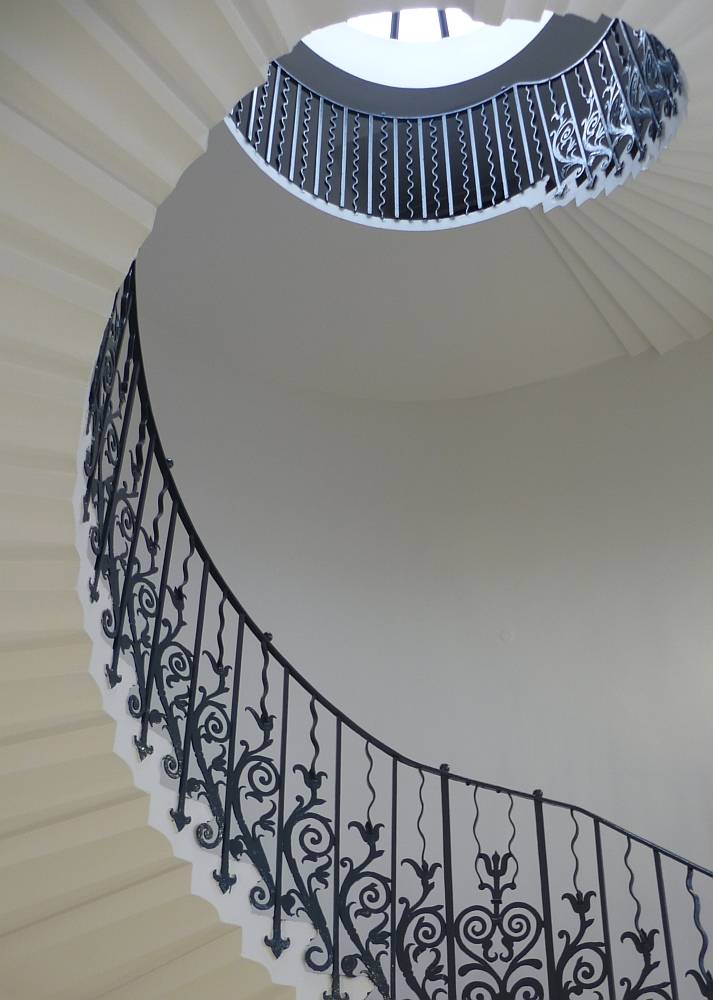
Left: The front elevation of the Queen's House, facing Romney Road, Greenwich. Right: The famous, gracefully spiralling "Tulip Stairs" inside.
Seen from between the two sides of the Old Royal Naval College, and opposite it on Romney Road, the Queen's House was started in 1616 by Inigo Jones (1573-1652) for Anne of Denmark, but finished in 1638 for Charles I's queen, Henrietta Maria. Wings were added later when it became a school for naval family's children in the late eighteenth century, and it was extended again in the early nineteenth century by Daniel Asher Alexander (1768-1846), who was praised by Sir John Soane for the "finely conservative spirit" with which he repaired Jones's existing fabric (Peach). Extra ranges were added in 1862 by Hardwick as well (see "Architecture and Views," and also the National Archives). Further additions, consisting of a gymnasium and assembly hall, were made in about 1874, "apparently by Colonel Clark of the Royal Engineers" (Cherry and Pevsner 257). The whole now forms the National Maritime Museum.
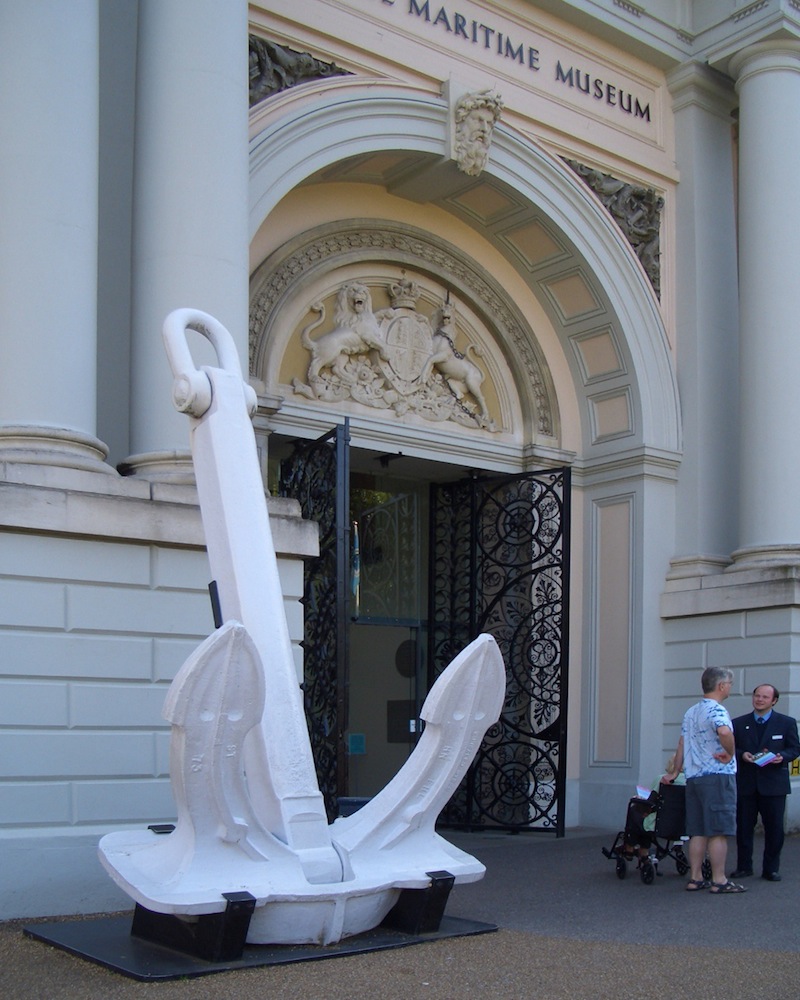
The main entrance portico to the National Maritime Museum, further along Romney Road.
More important than the Victorian work itself was the general influence of Jones's original building on the architecture of the day. He had brought in the ideas of the sixteenth-century Italian architect Andrea Palladio, creating a purely classical villa, its hall "a perfect 40 foot cube" (Visitor Map), its stairs, leading up to the Great Hall and the second floor, the very last word in elegance. It would inspire the whole neo-classical movement in architecture. "It is not, of course, suggested that, had he never lived, England would not have assimilated the Classical and Renaissance styles," says Kenneth Clark, but "Inigo's genius gave to our architecture the direction which it maintained for at least 150 years" (2). His influence also armed one side of the great Battle of the Styles in the mid-Victorian period. In short, the prototypical Queen's House is a key building for anyone interested in the architectural trends of the Victorian period.

Catching a Mermaid (1883), by James Clarke Hook, © The National Maritime Museum, Greenwich, London.
As stated above, the Queen's House is now part of the grand museum complex here, and galleries on the second floor of the house display a fine collection of maritime paintings and portraits, some by artists active in the Victorian period, such as James Clarke Hook (1819-1907), perhaps the best-loved of all Victorian sea-artists, much admired by Ruskin and Ford Madox Brown (see Barringer). In the well-known painting shown on the right, on display in one of the "Art for the Nation" galleries, Hook shows a boy hauling in a figurehead from a rough sea. A girl, probably his sister, holds back a smaller boy who is probably his younger brother. The family group and the whimsical title offset what seems to be tragic proof of a maritime disaster.
Displays change, but amongst many items of Victorian interest in the rest of the National Maritime Museum at the time of writing is one showing the history of the East India Company an understanding of which is hugely important to scholars of the period. Probably more permanent is the installation of the whole of a royal barge which was constructed for Frederick, the then Prince of Wales, in 1732 — and which was last used on the River Thames for Prince Albert.
The Pepys Building
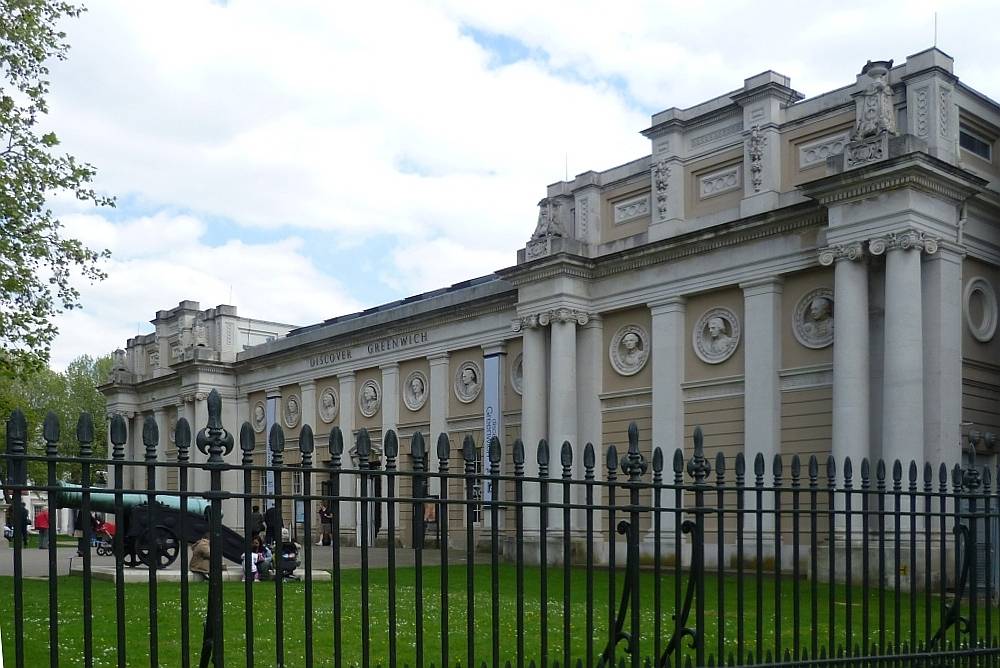
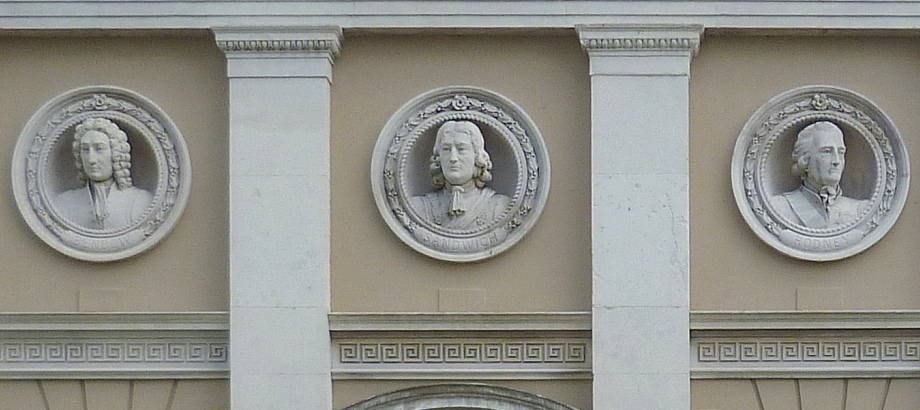
Left: The Pepys Building, just west of the Old Royal Naval College. Right: Closer view of some of the medallion portraits on the façade
The Pepys Building was designed by two Victorian Royal Engineers: the western part (built 1874-75) was by Colonel Clarke again, the matching eastern part (1882-83) by General Pudsey. Working all over the empire, the Royal Engineers were the unsung heroes of the architectural community, and here, as so often, very little is known about them. The building, which once housed rackets courts, and then an engineering laboratory, has "a giant order of attached columns, rustication, and medallion decoration, somewhat in the tradition of Cockerell" (Cherry and Pevsner 265). Now, serving as the "Discover Greenwich Visitor Centre," it is a useful first port of call in Greenwich. All the decoration, including the series of medallions of nautical heroes shown above, was by Charles Raymond Smith (1801/2-88) — about whom, again, little is known. Shown here are Admiral Benbow (1653-1702, once Evelyn's tenant at Deptford); the Earl of Sandwich (probably the 4th Earl, 1718-1792, who became 1st Lord of the Admiralty); and Admiral Rodney (also 1718-1792). Inside are a number of fine sculptures of other such worthies, by the sculptors Thomas Milnes, Count Gleichen, and others.
The Cutty Sark

The newly restored Cutty Sark, now been fitted out with lifts and air-conditioning, and afloat on a glass hospitality capsule.
As if all this was not enough, just beside the Pepys Building looms the recently reopened Cutty Sark, originally launched in 1869 at the end of the sail-ship era. Although she "carried her last cargo of tea in 1877 ... she discovered a new career in the wool trade to Australia, and in the late 1880s and early 1890s made the fastest passage home several times" (Aslet 274). Many would prefer to see her still authentically grounded in dry dock, as she was before her recent restoration. But her new elevation makes it easier to appreciate her design secrets, and she is a spectacular reminder of British ship-building skills and trading enterprise in the Victorian period. Her masts with their rigging and bunting rise higher into the sky now, as well, giving the whole World Heritage site a festive air.
Dickens loved the festive side of Greenwich, describing the Greenwich Fair vividly in Chaper 12 of Sketches from Boz. The Greenwich Hospital was particularly dear to Victorian hearts: "Taken from any point of view it is 'a palace,'" wrote Anna Maria and Samuel Carter Hall in 1859. They found it "beautiful in construction, graceful in all its proportions, as grand and imposing a structure as any nation of the modern world can show..... especially striking when seen as we voyage the Thames, either upwards or downwards" (479). But it is worth remembering that, as well as enjoying Greenwich, the Victorians contributed to its many attractions. The work of their architects, sculptors and artists is better represented in this older historic site than we might have thought.
Related Material
- Greenwich Hospital, engraving, and full commentary by the Halls
- Greenwich Hospital, engraving by G. Ayton Symington
- Greenwich Hospital (a cartoon in the 1864 Fun)
- The royal barge originally made for Prince Frederick
Bibliography
"Architects and Artists S." Sussex Parish Churches. Web. 17 May 2012.
Aslet, Clive. The Story of Greenwich. Cambridge, Mass.: Harvard University Press, 1999.
Barringer, Tim. "Hook, James Clarke (1819-1907)." Oxford Dictionary of National Biography. Online ed. Web. 17 May 2012.
Cherry, Bridget, and Nikolaus Pevsner. London 2: South. The Buildings of Eng;land series. London: Penguin, 1983.
Clark, Kenneth. The Gothic Revival. London: Penguin (Pelican), 1964.
Evelyn, John. The Diary of John Evelyn, Vol. 3 (1677-1706). London: Routledge/Thoemmes Press, 1996.
Hall, Samuel Carter and Anna Maria. The Book of the Thames. 5th ed. Teddington: Charlotte James, 1980.
Maritime Greenwich World Heritage Site Management Plan. (Steering Committee's proposals). Web. 17 May 2012 [original source no longer found online].
"Maritime Memorials." National Maritime Museum. Web. 17 May 2012.
Mee, Arthur. The Book of London. The King's England Series. London: Hodder and Stoughton, 1937.
National Archives Catalogue (gives brief descriptions of six plans for work on the Greenwich Hospital school signed by Hardwick). Web. 17 May 2012.
Peach, Annette. "Alexander, Daniel Asher (1768-1846)." Oxford Dictionary of National Biography. Online ed. Web. 17 May 2012.
The Queen's House: Visitor Map. Available at the House.
"Royal Naval College, Pepys Building, Greenwich." British Listed Buildings. Web. 17 May 2012.
Weinreb, Ben, et al. The London Encyclopaedia. 3rd ed. London: Macmillan, 2008.
Created 17 May 2012
Last modified 19 August 2023